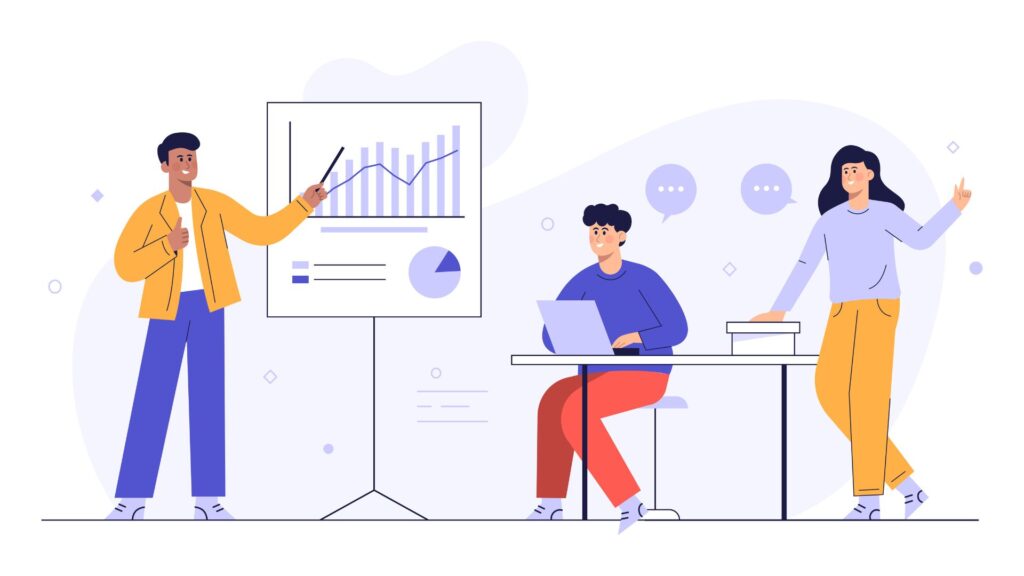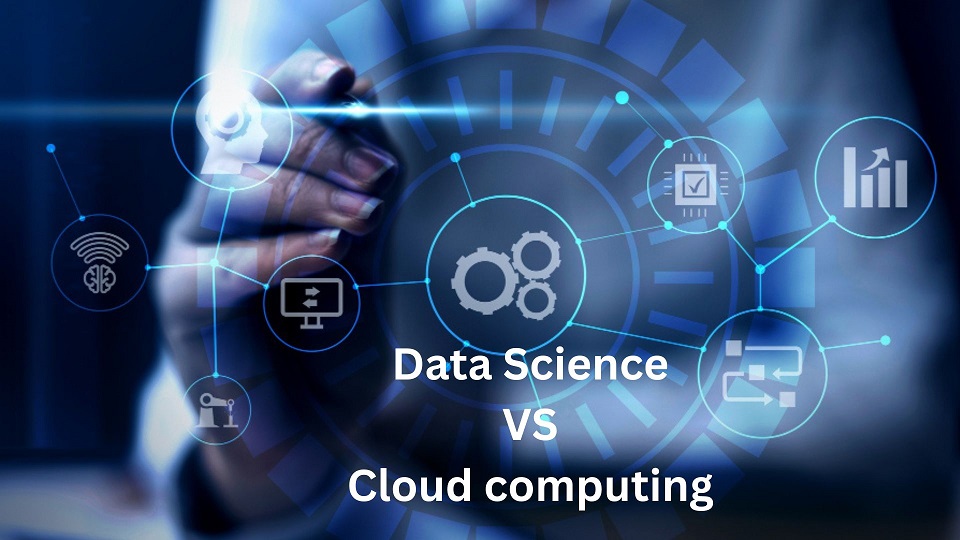Data Science Vs Cloud Computing What is the Difference ?
Data science and cloud computing are two distinct but interconnected fields within the technology industry.
Table of Contents
ToggleWhat is Cloud Computing ?
The supply of computer resources, such as servers, storage, databases, software, and networking, through the internet is referred to as cloud computing. Cloud computing enables customers to access and utilise these resources from cloud service providers on-demand rather than relying on local infrastructure and physical hardware.
Cloud computing's basic characteristics and elements include:
On-Demand Access:
Users who use cloud computing can access computer resources instantaneously and as needed without having to manage infrastructure or set up physical infrastructure. When necessary, resources can be supplied and scaled up or down.
Scalability
To manage shifting workloads, cloud platforms offer the flexibility to expand resources like computational power and storage. This adaptability enables businesses to quickly respond to shifting customer needs without over- or under-allocating their resources.
Pay-as-You-Go Model:
A pay-as-you-go or subscription-based pricing model is common for cloud services. Users are charged for the resources they use, which helps match expenses with actual utilization and hence optimize costs.
Virtualization
Virtualization technologies, which make it possible to create virtual instances of servers, storage, and networks, are a major component of cloud computing. The administration, isolation, and allocation of resources are all made possible through virtualization.
Service Models:
1.Infrastructure as a Service (IaaS):
Users can access virtualized infrastructure resources like networks, storage, and virtual computers. While the cloud provider maintains the physical infrastructure, they are in charge of overseeing and managing the underpinning infrastructure.
2.Platform as a Service (PaaS):
Without worrying about the underlying infrastructure, users may create, deploy, and manage apps on a cloud platform. A platform containing development tools, databases, and runtime environments is offered by the supplier, who also controls the infrastructure.
3. Software as a Service (SaaS)
Without requiring local installation, users can access software applications immediately through the internet. Infrastructure, middleware, and application functionality are all managed by the provider.
Deployment Models:
a. Public Cloud: A cloud service provider owns and manages resources that are made available through a public network. The infrastructure is shared by several clients.
b. Private Cloud: Resources can be hosted on-site or in a private data centre and are devoted to a single organisation. The infrastructure is under the organization’s control, and it can be modified to meet certain needs.
c. Hybrid Cloud: A fusion of public and private cloud systems that enables businesses to take use of both. It makes it possible for applications and data to move between the two environments with ease.
Cost savings, scalability, flexibility, better resource utilisation, and lower maintenance costs are just a few advantages of cloud computing. It has revolutionised the ways in which businesses create and deploy apps, hold and analyse data, and work together globally, enabling creativity and agility in the current digital environment.
What is Data Science ?
The interdisciplinary discipline of data science involves the extraction of knowledge, insights, and useful information from both structured and unstructured data. In order to analyse and interpret data, it incorporates aspects from a variety of disciplines, including statistics, mathematics, computer science, and domain experience. This helps to solve complicated problems, make educated decisions, and promote business outcomes.
The fundamental techniques and components of data science encompass:
Data collection and education
Databases, APIs, web scraping, sensors, and other record streams are only some of the sources that scientists use to collect and accumulate information. They then prepare the information for analysis by cleansing, remodeling, and preprocessing it.
Exploratory fact evaluation (EDA)
To realize the underlying patterns, distributions, and relationships in the facts, EDA involves inspecting and visualizing the facts. To acquire insights and notice viable troubles or anomalies, methods such as information visualization, record profiling, and precis records are used.
Statistical analysis:
To discover widespread styles, correlations, and developments within the statistics, scientists use statistical strategies and hypothesis checking. This encompasses strategies like category, grouping, regression analysis, and hypothesis checking out.
System mastering
Predictive Modeling:
data scientists construct predictive fashions using systems, gaining knowledge of algorithms to forecast destiny effects based totally on ancient information. Those methods are used to make predictions, classify statistics, detect anomalies, or phase the records into meaningful corporations.
Records Visualization:
Statistics scientists appoint statistics visualization strategies and gear to symbolize complicated records in visual formats consisting of charts, graphs, and dashboards. Powerful record visualization enables you to communicate insights and findings to stakeholders in a clear and intuitive way.
Big Information Analytics:
With the exponential growth of records, records scientists paint with huge statistics technologies and frameworks consisting of Apache Hadoop, Apache Spark, and allotted computing to manner and examine large datasets effectively.
Domain information:
statistics scientists regularly work closely with area professionals to gain a deep understanding of the precise industry or hassle they may be addressing. This domain understanding allows for framing the problem, identifying applicable capabilities, and interpreting the outcomes in a meaningful context.
Numerous industries, including business analytics, finance, healthcare, marketing, social sciences, and more use data science. It is essential for drawing conclusions from data, making data-driven choices, creating predictive models, and encouraging innovation and expansion inside organisations.
Difference between data Science and Cloud Computing
Aspect | Data Science | Cloud Computing |
Focuses | Focuses on extracting insights and knowledge from data | Focuses on delivering on-demand computing resources over the internet |
Activities | Activities include data collection, cleaning, exploration, statistical analysis, machine learning modeling, and data visualization | Activities include infrastructure provisioning, resource management, virtualization, deployment, and maintenance of cloud-based services and applications |
Expertise | Expertise in statistics, mathematics, programming, and domain knowledge | Expertise in managing cloud infrastructure, virtualization technologies, networking, security, and system administration |
Applied | Applied in various domains for data-driven decision-making, predictive modeling, pattern recognition, and insights generation | Applicable across industries for hosting applications, storing and processing data, and leveraging scalable computing resources |
Output | Output includes actionable insights, predictions, recommendations, and data-driven solutions | Output includes a scalable and flexible computing infrastructure, platform services, and software applications |
Industry Applications | Finance, healthcare, marketing, e-commerce, etc. | Across various industries for hosting applications, data storage, etc. |
Examples of Technologies/Tools | Python, R, TensorFlow, Tableau | Amazon Web Services (AWS), Microsoft Azure, Google Cloud Platform (GCP) |
End User Experience | Direct interaction with data and generating insights | Interacting with cloud-based applications or services |
Tools and Technologies | Python, R, statistical packages, ML frameworks, visualization tools | Cloud service provider tools, virtualization technologies |
Data vs. Infrastructure Focus | Analysis, manipulation, and interpretation of data | Management and provisioning of computing resources |
Usage | Data-driven decision-making, predictive modelling | Application deployment, big data analytics, storage |
Skill Sets | Statistics, programming, machine learning, data analysis | Cloud infrastructure, virtualization, networking |
purpose | Extract insights and make data-driven decisions | Provide scalable and flexible computing resources |
Data Source | Works with various data sources such as databases, files, APIs | Utilizes data from different sources for processing and storage
|
Data Manipulation | Cleans, preprocesses, and transforms data for analysis | Provides storage and processing capabilities for data |
Analysis Techniques | Utilizes statistical analysis, machine learning, data mining, and visualization techniques | Provides infrastructure for data processing and analytics |
Scalability | Limited scalability based on computational resources | Offers high scalability to handle large workloads and data |
Cost Structure | Typically requires investments in tools, software, and skilled professionals | Pay-as-you-go model, where costs are based on resource usage |
Security | Focuses on data privacy, compliance, and ethical considerations | Emphasizes security measures to protect data and infrastructure |
Performance | Performance depends on computational resources and algorithm efficiency | Performance depends on the scalability and efficiency of the cloud infrastructure |
Data Ownership | Focuses on analyzing and extracting insights from data | Ensures data storage and security while maintaining data integrity |
Use Cases | Predictive analytics, recommendation systems, fraud detection, market analysis | Application hosting, big data processing, IoT data management |
Collaboration | Collaborates with domain experts and stakeholders to understand business requirements | Collaborates with IT teams to deploy and manage cloud-based services |
Learning Curve | Requires expertise in statistics, machine learning algorithms, programming languages, and domain knowledge | Requires understanding of cloud infrastructure, virtualization, and networking concepts |
Impact on Business | Helps businesses make data-driven decisions and gain a competitive advantage | Provides cost savings, agility, and scalability for businesses |

Data Science vs Cloud Computing Similarities
Aspect | Data sciecne | Cloud computing |
Data | Both deal with large volumes of data | Both involve processing and analyzing big data efficiently |
Scalability | Emphasize scalability and resource allocation | Offer scalable infrastructure and resources for data-intensive tasks |
Virtualization | Utilize virtualization technologies | Employ virtualization for resource provisioning and management |
Cost | Focus on cost optimization and efficiency | Offer pay-as-you-go pricing models for resource consumption |
Collaboration | Involve collaboration and sharing | Facilitate collaborative development and deployment of applications |
Automation | Emphasize automation and orchestration | Provide tools for automating infrastructure provisioning and management |
Computing | Utilize high-performance computing resources | Offer high-performance computing capabilities for efficient execution |
Data storage | Require data storage and management | Provide cloud-based storage services for efficient data access and retrieval |
Analytics capabilities | Enable scalable analytics capabilities | Offer analytics platforms and services for data analysis and insights |
Platforms | Leverage cloud platforms for data processing | Utilize cloud computing infrastructure and services for data science tasks |
How Do Data Science and the Cloud Relate?
How Do Data Science and the Cloud Relate?
If you are familiar with the Data Science process, you would be aware that the great majority of Data Science tasks are often carried out on a Data Scientist’s personal computer. R and Python would often be installed together with the data scientist’s IDE. The other necessary development environment configuration includes associated packages that must be manually installed or installed using a package management similar to Anaconda.
Typical iterative workflow process steps are as follows:
1) Creating, approving, and testing models, such as predictions and recommendation models
2) Handling, cleaning, munging, parsing, and transforming data
3) Data mining and analysis techniques including exploratory data analysis (EDA), summary statistics, etc.
4) Collecting data
5) Improving or adjusting models or deliverables

